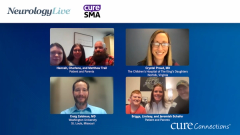
Next Steps for Suspected SMA in Children and Adolescents
Experts explain the next steps for families and physicians after SMA is suspected in a child.
Episodes in this series

Crystal Proud, MD: When the physician is observing signs and symptoms of weakness, what’s their next step? If they suspect that they have a patient with weakness, what do they do next?
Craig Zaidman, MD: It’s a phone call. It’s hard to get in to see me in the clinic. It’s probably easier for you, Dr Proud, because you have more clinic spaces than I do. You see patients daily, and I see patients once a week. A phone call is important, because with a referral to somebody like us, we can help you initiate the free genetic testing to look for spinal muscular atrophy [SMA]. As long as the patient is being referred to me, I’m completely comfortable initiating both processes at once. A patient could have a genetic test ordered and sent to their home, and they can mail it back. The genetic testing can be pending while they’re waiting for their appointment to see me. If it’s positive, then we know exactly what to do, and that might even speed up the appointment. If it’s negative, then I still need to see them, but we go in a different direction with the diagnostic testing.
Crystal Proud, MD: We spoke earlier regarding the emergent nature of pursuing such a diagnostic test. Like your clinic, my clinic is a phone call. When there’s a suspicion of SMA, my nurse—especially my neuromuscular nurse coordinator, who’s usually receiving this information even if it goes through the front desk—is going to hear that trigger word, which is possible SMA. That’s going to expedite the process of getting that appointment in. Usually the answer is, “How fast can you get in a car and get here? I’ll see you then,” or, “I’ll see you tomorrow.” It’s usually 1 of those 2, pending travel logistics.
Craig Zaidman, MD: I agree. Because we’re speaking with other physicians, the challenge is when you have a patient like Briggs and the referral comes in that says flat feet, which we’ve gotten plenty of referrals for. It’s important for a referring doctor to understand that with a referral diagnosis that says low tone, which is often how these come—especially now that we get a lot of referrals that require you to select a click button to even make the referral—doctors like you and me need a couple of sentences about what’s going on; low tone doesn’t help us. It doesn’t help us prioritize a potential emergency referral from all the other referrals we get.
Crystal Proud, MD: That’s a great point about navigating through that chief complaint that comes through the fax machine or is scribbled down from a phone call at the front desk. Because the referring physician may know that there’s weakness or may see that there’s an unsteady gait, these are the terms that may come to mind. They may not even know that SMA is on the differential. If we see SMA, that’s easier to expedite. But weakness makes up a large proportion of what we see in our clinic every day. The capacity to expedite that may be impacted without more information. I completely agree that a couple of sentences summarizing the concerns are going to help folks categorize how urgent this appointment is.
Craig Zaidman, MD: As Hannah and Briggs have demonstrated, the key is that it’s a child who’s weak but otherwise perfectly delightful. When Dr Proud and I see that wonderful, social, bright child who can’t sit up or is falling while walking, we know that’s the emergency situation. We know that’s a kid who might have spinal muscular atrophy. That’s the information we need from the referring doctor, not developmental delay without any other modifiers on it. That makes it hard for us to triage these referrals.
Crystal Proud, MD: When we see that characterization that you nicely described where we have an engaging social individual who’s either failing to meet motor milestones or losing motor milestones or distinct from their peers in how they accomplished motor milestones, those are all red flags. Because we now have treatment interventions and options for therapies for spinal muscular atrophy, my colleagues joke that, in my clinic, if you present with weakness, you have SMA until proven otherwise. I know I can do something if I diagnose you with spinal muscular atrophy. It’s important that I investigate for that so I don’t miss an opportunity to pursue treatment for you.
Transcript edited for clarity.
Newsletter
Keep your finger on the pulse of neurology—subscribe to NeurologyLive for expert interviews, new data, and breakthrough treatment updates.



























